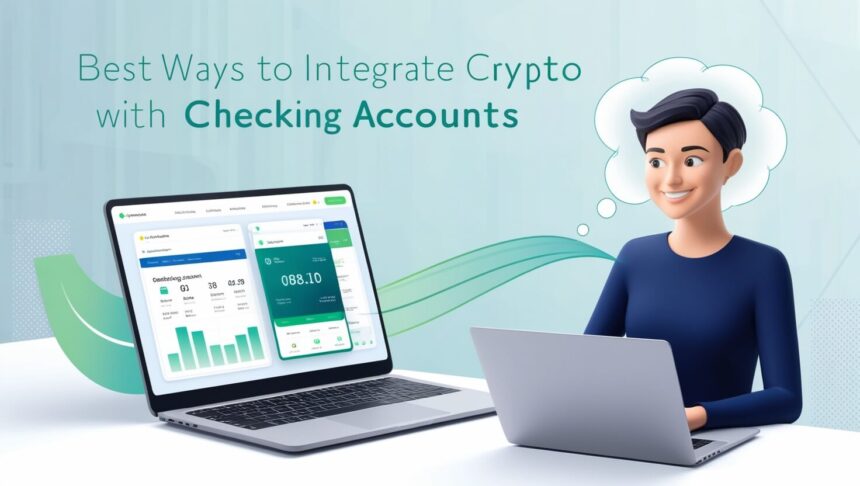In the article, I will explain the Best Ways to Integrate Crypto with Checking Accounts. I will provide real world answers that meet both the banking and digital asset worlds half way.
These include crypto debit cards, bank collaborations, stablecoin adoption, and crypto collateral loans.
All these methods allow integration of cryptocurrency and fiat currency in daily spending. The transactions are secure, efficient, and easy for everyone to adopt.
Best Ways to Integrate Crypto with Checking Accounts
| Key Point | Explanation |
|---|---|
| Crypto Debit Cards | Allow users to spend crypto directly from their checking accounts using debit cards linked to exchanges like Coinbase or Binance. |
| Bank Partnerships with Crypto Exchanges | Some banks partner with exchanges to directly deposit or withdraw crypto into checking accounts, simplifying integration. |
| Stablecoin Integration | Using stablecoins like USDC or Tether for seamless conversion to fiat within checking accounts, providing stability. |
| Crypto-to-Fiat Conversion Services | Services like BitPay or Gemini enable quick conversion of crypto into fiat currency, which can be sent to checking accounts. |
| Blockchain Payment Gateways | Integration of blockchain-based payment systems (e.g., Flexa, BitPay) that allow crypto payments to be transferred to a checking account. |
| Direct Crypto Deposits | Some platforms, like Kraken, allow crypto direct deposit features into traditional accounts, facilitating easier access to funds. |
| Cross-Border Remittance with Crypto | Using crypto as a faster and cheaper alternative for international transfers to checking accounts. |
| Crypto-Backed Loans | Borrowing against crypto holdings, with loan proceeds deposited into checking accounts, offering liquidity without selling crypto. |
1. Crypto Debit Cards
Crypto debit cards allow carrying out transactions with a crypto account, enabling the digital asset holder to spend cryptocurrency on every seller that accepts cards with the logo of Mastercard and Visa.
Most of these debit cards are issued by a crypto favorable bank in collaboration with Transit payment systems.

Customers can load their debit cards with the desired amount of crypto currency, which at the day of the transaction is converted into the country’s currency immediately.
This provides instant economic benefits and compliance with the legal requirements of the economy.
2. Bank Partnerships with Crypto Exchanges
Some conventional banks have started establishing deals with crypto platforms to offer banking services related to assets in digital form.
Such partnerships enable the customers to authorize direct linkage of their checking accounts to crypto enabled platforms.

And these features are very simple to use. The bank customers are also able to sell or purchase the digital currency which will be reflected in his account directly.
With the addition of crypto exchange capabilities, a bank can facilitate transactions with digital currencies in real time without increasing costs or lowering the quality of its security.
With this, it stands to link the conventional world of finance to the floating assets and amazing digital world and make the digital currency globally accepted.
3. Stablecoin Integration
With the integration of available for public use US stable currencies like USDC and USDT, there is now a possibility for an easier transaction through a checking account without worrying about the instability of the cryptocurrency market.

By making it possible to deposit, withdraw, and make payments in stablecoins, banks can allow customers to benefit from digital currency without the unpredictable price changes.
Both businesses and people can use stablecoins for tasks such as payroll, remittance, and day-to-day activities and still enjoy low fee charges and quick settlement in comparison to traditional banking systems.
4. Switching from Crypto to Fiat
Users are now able to use crypto exchanges as well as some third party payment processors for fast conversion services which enable them to convert cryptocurrencies into traditional currency that is then sent to their bank accounts.

These services guarantee that users can easily liquidate their digital assets when required. Some exchanges even enable automated conversions
Where users can receive fiat payments from crypto transactions with no waiting period. This allows people to use crypto for day-to-day expenses, increasing the usability of crypto.
5. Gateways of Blockchain Payment
Blockchain payment gateway allows merchants to convert crypto into fiat cash instantly. Some of these payment processors offer bank integration features where the received crypto automatically gets converted to the merchant’s checking account.
This allows the merchant to accept digital currency while removing the worry of changing prices. Businesses are now able to incorporate these payment gateways directly into their checkout systems which allow them to accept Bitcoin and Ethereum without fear of price swings.
6. Indirect Cryptographic Funding
Currently, some banks and other financial companies are allowing funding directly to checking accounts either in the form of stablecoins or converted fiat in real time.

With this integration, users can now manage their crypto earnings, salaries, and payments without needing third-party services to convert them into other currencies.
Banks that adopt this technology will be able to gain incentive from knowledgeable crypto users, all while providing better banking services to their customers in relation to the digital currency world.
7. Cross-Border Remittance With Cryptocurrency
Using cryptocurrency is much cheaper and faster than using the traditional methods of remittance. Banks can allow users to make ifnternational orders over their checking accounts with little fees and quicker times, allowing them to bypass normal remittance strategies.
Funds can be received as either cryptocurrency or fiat currency using either form of payment and can be deposited into the user’s checking account.
These integrations are beneficial to freelancers, business people, and other users performing transactions from different countries.
8. Crypto-Backed Loans
Thanks to loans backed with cryptocurrency, users can get a direct deposit into their checking account as long as they provide a certain amount of cryptocurrency as collateral.
These types of loans solves the lquidity issue for crypto investors, allowing them to keep their assets intact.

Letting people pay for services with slower interest rates and quicker approvals encourages more crypto investors to seek these flexible financial solutions.
Crypto backed lending is gaining traction since it provides more value to the people who need to borrow money.
Conclusion
Merging cryptocurrency with checking accounts maximizes financial flexibility, convenience, and efficiency. Spending digital assets on everyday transactions is made easier with crypto debit cards and crypto-to-fiat conversion services.
The partnership between banks and crypto exchanges along with direct crypto deposits form frictionless borders between traditional finance and crypto.
Stablecoin integration along with payment gateways on the blockchain further enhances payments, especially for businesses, due to their speed and stability.
For larger financial needs, liquidity can be provided through crypto backed loans without the need for asset liquidation. Finally, using cryptocurrency for cross-border remittance payments provides a quick and inexpensive method to transfer funds internationally.










